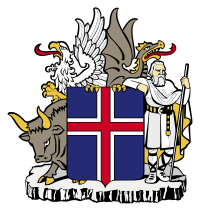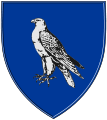- Coat of arms of Iceland
-
Coat of arms of Iceland
Icelandic: Skjaldarmerki Íslands
Details Adopted July 1, 1944 Escutcheon Flag of Iceland (azure, a cross gules fimbriated argent) Supporters Landvættir Compartment columnar basalt plate Use 111100 The coat of arms of Iceland (skjaldarmerki Íslands) is a cross of silver on a sky-blue shield, with a fire-red cross inside the silver cross (similar to the Icelandic flag). The shieldbearers are the four protectors of Iceland (landvættir) standing on a pahoehoe lava block. The bull (Griðungur) is the protector of southwestern Iceland, the eagle or griffin (Gammur) protects northwestern Iceland, the dragon (Dreki) the northeastern part and the Rock-giant (Bergrisi) is the protector of southeastern Iceland. Great respect was given to these creatures of Iceland, so much that there was a law during the time of the Vikings that no ship should bear grimacing symbols (most often dragonheads on the bow of the ship) when approaching Iceland. This was so the protectors would not be provoked unnecessarily[citation needed].
The landvættir (“land wights”) also decorate the obverse (front) of the Icelandic króna coins, but animals of the ocean (fish, crabs and dolphins) appear on the reverse (back). The Icelandic presidency uses a swallowtailed Icelandic flag with the coat of arms. The National Commissioner of Icelandic Police uses a white flag with the coat of arms, when the use of the State flag is not warranted, and so may some other state services do as well.
The shield may be blazoned, Azure, on a cross argent a cross gules.
History
Iceland has had various distinct coats of arms through the ages: depicted below.
- The first one is believed to have been a shield with six blue stripes and six silver stripes, possibly signifying the 12 þings of the Icelandic Commonwealth.
- The second one is believed to be the one that was given to Earl Gissur Þorvaldsson by the King of Norway, Hákon Hákonarson, during 1258. It was patterned on the King's own coat of arms, exchanging the colors of the shield with the color of the lion and adding the blue and silver stripes of the previous coat of arms.
- Around or after 1500, the Icelandic coat of arms became a crowned stockfish on a red shield. It is known as the Þorskmerkið (“the cod markings”) and the fish was depicted occasionally in a variant form.
- On October 3, 1903, the coat of arms of Iceland was changed to a white falcon on a blue shield. It remained in use until the first version of the coat of arms with the landvættir became official on February 12, 1919, as the coat of arms of the Kingdom of Iceland. The falcon still remained in the royal coat of arms throughout the reign of King Christian X even though Iceland had become a republic in 1944.
- When independence was declared on June 17, 1944, the present coat of arms was adopted.
-
The coat of arms of the Icelandic Commonwealth
-
The coat of arms of the Kingdom of Iceland 1919 to 1944
See also
- Flag of Iceland
- Icelandic heraldry
External links
- The Icelandic Prime Minister's Office on the Coat of Arms
- Official website of the President of Iceland on national heraldry
Coats of arms of Europe Sovereign
states- Albania
- Andorra
- Armenia
- Austria
- Azerbaijan
- Belarus
- Belgium
- Bosnia and Herzegovina
- Bulgaria
- Croatia
- Cyprus
- Czech Republic
- Denmark
- Estonia
- Finland
- France
- Georgia
- Germany
- Greece
- Hungary
- Iceland
- Ireland
- Italy
- Kazakhstan
- Latvia
- Liechtenstein
- Lithuania
- Luxembourg
- Macedonia
- Malta
- Moldova
- Monaco
- Montenegro
- Netherlands
- Norway
- Poland
- Portugal
- Romania
- Russia
- San Marino
- Serbia
- Slovakia
- Slovenia
- Spain
- Sweden
- Switzerland
- Turkey
- Ukraine
- United Kingdom
- (England
- Northern Ireland
- Scotland
- Wales)
- Vatican City
States with limited
recognition- Abkhazia
- Kosovo
- Nagorno-Karabakh
- Northern Cyprus
- South Ossetia
- Transnistria
Dependencies
and other territories- Åland
- Faroe Islands
- Gibraltar
- Guernsey
- Jan Mayen
- Jersey
- Isle of Man
- Svalbard
Other entities Categories:- National coats of arms
- National symbols of Iceland
Wikimedia Foundation. 2010.






